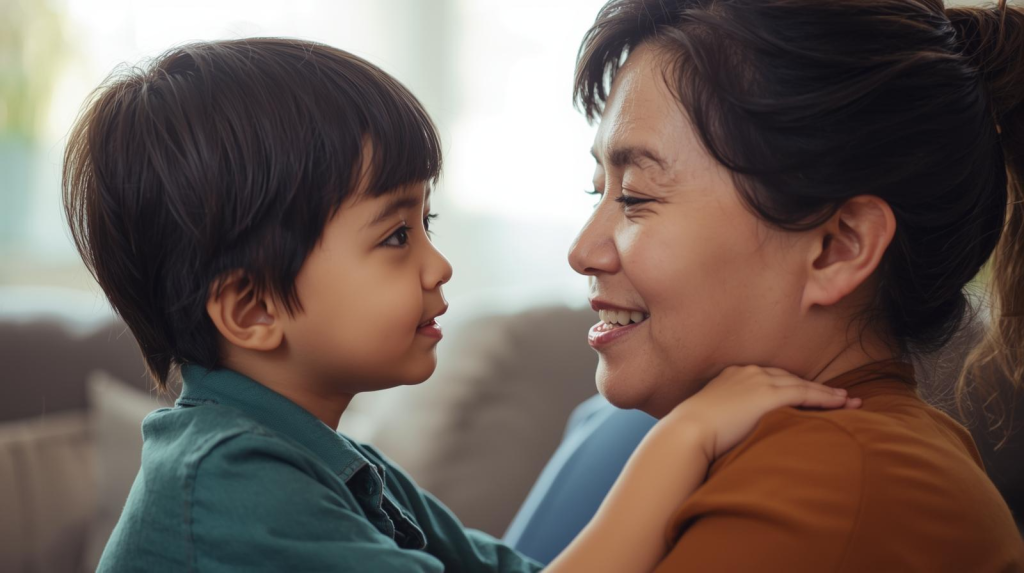This article explores effective parenting techniques to foster emotional safety and resilience in children through reassurance and empathy.

Creating a nurturing environment for children is essential for their emotional development. Emotional safety in parenting means providing a space where children feel secure, understood, and validated. This article will delve into practical techniques for parents to cultivate emotional safety through reassurance, active listening, and consistent support. By implementing these strategies, parents can help their children build resilience and navigate their emotions effectively.
Key Takeaway
- Reassurance and validation are crucial for fostering emotional safety in children.
- Consistent and predictable parenting helps build trust and security.
- Active listening and empathy encourage open communication and emotional expression.
Understanding Emotional Safety in Parenting
Credits: Therapy in a Nutshell
Emotional safety is a cornerstone of healthy child development. It’s about creating an environment where children feel secure enough to express their feelings without fear of judgment. When parents validate their children’s emotions, it sends a clear message: “Your feelings matter.” This validation helps children learn to regulate their emotions and fosters a sense of trust in their caregivers.
In many ways, emotional safety is akin to physical safety. Just as children need to feel secure in their surroundings, they also need to feel secure in their relationships. This security allows them to explore the world, knowing they have a safe place to return to. It’s a delicate balance, but one that can be achieved through consistent parenting practices.
Building Trust with Children
Trust is built over time through consistent actions and words. When parents are predictable in their responses, children learn that they can rely on them. This reliability is crucial for emotional safety. For instance, if a child knows that their parent will always listen when they are upset, they are more likely to open up about their feelings.
The Role of Routines
One way to build trust is through consistent routines. Routines provide a sense of stability and predictability, which can be comforting for children. Whether it’s a bedtime ritual or a weekly family activity, these routines help children feel secure and connected to their parents.
Validating Child Feelings
Validation is a powerful tool in parenting. When a child expresses a feeling, whether it’s sadness, anger, or joy, acknowledging that feeling can make a significant difference. Instead of dismissing their emotions or telling them to “calm down,” parents can say things like, “I see that you’re really upset right now.” This acknowledgment helps children feel understood and valued.
Importance of Emotional Validation
Moreover, validating feelings doesn’t mean agreeing with the child’s perspective. It simply means recognizing their emotions as real and important. This practice encourages children to express themselves openly and honestly, knowing that their feelings will be accepted.
Parenting Reassurance Techniques
Reassurance can take many forms in parenting. It can be verbal, such as saying, “I’m here for you,” or physical, like a comforting hug. The key is to be attuned to your child’s needs and respond appropriately.
Active Listening
- Active Listening: This involves giving your full attention to your child when they speak. Put away distractions, make eye contact, and show that you are genuinely interested in what they have to say. This practice not only reassures children but also models effective communication skills.
- Emotion Coaching: Teaching children to understand and label their emotions can be incredibly beneficial. When parents help children identify their feelings, it empowers them to manage those emotions more effectively. For example, saying, “It sounds like you’re feeling really frustrated. That’s okay,” can help children feel validated and understood.
- Consistent Responses: Children thrive on consistency. If a child knows that their parent will respond in a certain way to their emotions, it creates a sense of safety. For instance, if a child falls and scrapes their knee, a calm and reassuring response from the parent can help soothe their distress.
Creating Secure Attachment
Secure attachment is vital for emotional safety. It forms when children feel consistently supported and loved by their caregivers. This attachment lays the groundwork for healthy relationships throughout their lives.
Being Present and Engaged
To foster secure attachment, parents should focus on being present and engaged. This means not only being physically available but also emotionally attuned. When children feel that their parents are genuinely interested in their thoughts and feelings, they are more likely to develop a secure attachment.
Encouraging Emotional Expression

Encouraging children to express their emotions is essential for their emotional development. Parents can create a safe space for emotional expression by being open about their own feelings. Sharing personal experiences can help children understand that everyone has emotions and that it’s okay to express them.
Setting Loving Boundaries
Setting clear and loving boundaries is also important. Children need to know that while their feelings are valid, there are appropriate ways to express them. For instance, teaching a child that it’s okay to be angry but not okay to hit can help them learn emotional regulation.
Calming Parenting Responses
How parents respond to their children’s emotions can significantly impact their emotional safety. Calming responses, such as taking deep breaths or using a soothing tone, can help de-escalate tense situations. When parents model calmness, children learn to regulate their emotions better.
Importance of Self-Care
It’s also important for parents to practice self-care. When parents are calm and centered, they are better equipped to handle their children’s emotional needs. Taking time for oneself can lead to more patient and understanding parenting.
Repairing Emotional Ruptures
No parent is perfect, and emotional ruptures can happen. Whether it’s a harsh word said in frustration or a missed opportunity to listen, it’s essential to repair these moments. Acknowledging mistakes and apologizing can go a long way in restoring trust and emotional safety.
Acknowledging Mistakes
Repairing emotional ruptures involves recognizing the impact of one’s actions on the child’s feelings. Parents can say things like, “I’m sorry I raised my voice. I didn’t mean to upset you,” to validate the child’s feelings and show that their emotions are important.
Providing Unconditional Support
Unconditional support is a cornerstone of emotional safety. Children need to know that they are loved and accepted, regardless of their behavior or feelings. This support fosters resilience and helps children navigate challenges with confidence.
Being There for Your Child
Parents can provide unconditional support by being there for their children during difficult times. Whether it’s a tough day at school or a personal struggle, knowing that their parents are in their corner can make all the difference.
Fostering Emotional Resilience
Emotional resilience is the ability to bounce back from adversity. Parents play a crucial role in fostering this resilience by teaching their children coping strategies and problem-solving skills. Encouraging children to face challenges and learn from them can help build their confidence and emotional strength.
Celebrating Small Victories
One way to foster resilience is to celebrate small victories. Acknowledging a child’s effort, even if the outcome isn’t perfect, reinforces the idea that trying is what matters. This approach helps children develop a growth mindset, which is essential for emotional resilience.
Positive Parent-Child Communication
Effective communication is key to emotional safety. Parents should strive to create an open dialogue with their children, where feelings can be expressed freely. This communication fosters trust and helps children feel secure in sharing their thoughts and emotions.
Using Open-Ended Questions
Using open-ended questions can encourage children to share more about their feelings. Instead of asking, “Did you have a good day?” a parent might ask, “What was the best part of your day?” This approach invites children to reflect and express themselves more fully.
Conclusion
Creating emotional safety through reassurance is a journey that requires patience and commitment. By validating feelings, building trust, and fostering open communication, parents can create a nurturing environment where children feel secure and understood. These practices not only help children navigate their emotions but also lay the foundation for healthy relationships throughout their lives. As parents, the goal is to cultivate a safe space where children can grow, express themselves, and develop the resilience they need to face the world.
FAQ
What exactly does “emotional safety” mean, and how is it different from just being a loving parent?
Emotional safety means your child feels secure enough to express any feeling—sadness, anger, fear, joy—without worrying about being dismissed, criticized, or punished for having that emotion. Being loving is part of it, but emotional safety is more specific: it’s about creating an environment where emotions themselves are always acceptable, even when behaviors might need limits. A loving parent might say “Don’t cry, you’re fine,” while an emotionally safe parent says “I see you’re upset. Tell me what’s wrong.” The difference is validation versus dismissal.
My child cries over everything. If I validate every feeling, won’t they become overly dramatic or manipulative?
Validating feelings doesn’t mean accepting all behaviors or eliminating consequences. You can say “I know you’re angry that I said no to more screen time, and it’s okay to feel angry” while still maintaining the boundary. Children aren’t being manipulative when they express big emotions—their brains are still developing emotional regulation skills. When you consistently validate their feelings while holding boundaries, they actually learn to manage emotions better over time. Dismissing feelings to “toughen them up” usually backfires, creating either more dramatic expressions or emotional shutdown.
I try to validate my child’s feelings, but it seems to make them more upset. What am I doing wrong?
Timing and delivery matter. If your child is in the middle of an intense emotional moment, validation alone won’t instantly calm them—they may need to release the emotion first. Also, check whether you’re truly validating or inadvertently minimizing. “I know you’re upset, but…” negates the validation. Instead, try pure acknowledgment: “You’re really angry right now” and then just be present. Sometimes children escalate briefly when finally feeling heard because they’ve been holding emotions in. This temporary increase often precedes genuine calming, so don’t abandon the approach too quickly.
How can I validate feelings I don’t understand or think are unreasonable?
You don’t need to understand or agree with a feeling to validate it. The emotion exists regardless of whether it makes sense to you. Try “I can see this is really upsetting to you” or “You’re having strong feelings about this.” You’re acknowledging their experience, not endorsing their interpretation of events. A child melting down over a broken cracker might seem unreasonable to you, but to a tired, hungry toddler with limited coping skills, it’s genuinely distressing. Validation acknowledges their reality without requiring you to share their perspective.
I grew up being told to toughen up and deal with things. Won’t emotional safety make my child weak?
Research consistently shows the opposite. Children who grow up with emotional safety develop better emotional regulation, stronger resilience, and healthier coping mechanisms than those whose feelings were dismissed. They learn to process and move through emotions rather than suppressing them until they explode later. “Toughening up” often creates adults who struggle with relationships, mental health, and stress management because they never learned healthy emotional processing. True strength comes from being able to feel and cope with emotions, not from pretending they don’t exist.
My partner thinks I’m coddling our child by being so emotionally available. How do we get on the same page?
Share resources about emotional development and the research on emotional safety’s long-term benefits. Sometimes partners who resist this approach had their own emotions dismissed as children and haven’t processed that experience. Have honest conversations about your shared goals—you probably both want a confident, resilient child. Discuss how emotional safety builds those qualities rather than undermining them. You might also model emotional validation with your partner, showing them how it feels to be heard. If disagreement persists, consider family counseling to work through different parenting philosophies.
References
- https://www.calm.com/blog/emotional-safety#:~:text=Emotional%20safety%20is%20built%20on,to%20manage%20someone%20else’s%20reactions.
- https://lifetimemontessorischool.com/how-and-why-create-emotional-safety-our-kids

